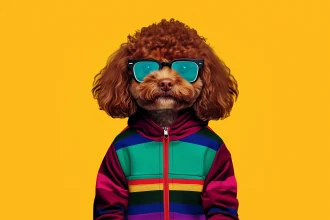As a dog walker in Portland, I get this question at least twice a week, usually from someone swooning over my client’s adorable doodle mix at the local dog park. And I get it – those teddy bear faces are hard to resist. But after five years of professional dog walking and caring for more than twenty Cavapoos, I’ve learned that understanding the real Cavapoo pros and cons matters more than those cute Instagram photos.
Cavapoo Pros and Cons Summed Up
Before we dive into the details, here’s what really matters about Cavapoo pros and cons:
The Pros:
- Adaptable personalities that fit most family dynamics
- Genuinely good with kids, elderly, and other pets
- Small enough for apartment living while sturdy enough for active lifestyles
- Highly trainable with the right positive approach
The Cons:
- Intensive grooming needs costing $1,000+ annually
- Separation anxiety that often requires professional help or daily dog walking
- Unpredictable adult sizes ranging from 9 to 25 pounds
- Higher than expected costs ($2,000-3,000 yearly) for proper care
These dogs can be wonderful companions, but they require more time, money, and emotional investment than most people expect. Let’s dig deeper into what life with a Cavapoo really looks like, beyond the designer breed hype and marketing claims.
Why Trust My Take on Cavapoo Pros and Cons
Ever wondered what dog walkers talk about when we get together? We swap stories about the dogs we work with – their quirks, challenges, and charm. Over craft beers at Portland’s dog-friendly patios, I’ve shared plenty about the Cavapoos on my client list. I’ve logged hundreds of hours observing these popular pups in action.
Unlike breeders (who see puppies for 8 weeks) or vets (who see dogs for 15 minutes at a time), I spend hours with these dogs daily in real-world situations. I see how they handle Portland’s notorious rain, react to bikes on the Eastbank Esplanade, and interact with other dogs at Powell’s Dog Park. When a client asks me about Cavapoo pros and cons, my answer comes from handling their anxieties and celebrating their successes.
I’ve also gotten brutally honest feedback from owners. Like my neighbour, who admitted he wasn’t prepared for his Cavapoo’s grooming needs, or one of my clients, who had to switch apartments because her pup’s separation anxiety was too much for her old building. These aren’t the polished stories you’ll find on breeder websites – they’re the real deal.
Physical Traits: The Good and The Challenging
Remember that “predict their adult size” chart you saw online? Well, my client roster suggests it’s more of a rough guess. Let me break down what I’ve actually seen:
Size Reality Check
Size predictions for Cavapoos often miss the mark by a mile. While most of my clients’ Cavapoos settle between 12-18 pounds, I’ve seen everything from tiny 9-pound adults to surprisingly sturdy 25-pounders. It’s particularly interesting when these size variations show up in the same litter – I’ve walked two siblings who ended up with a 10-pound difference between them. Height typically ranges from 9-14 inches, but like weight, it’s more of a suggestion than a guarantee. This unpredictability can have real implications for everything from harness sizes to exercise needs, so it’s something prospective owners should be prepared for.
Coat Types and The Truth About Maintenance
The reality of Cavapoo coats is far from the “low-maintenance” promise many breeders make. The most common coat I see is wavy – think teddy bear texture that looks adorable in photos but requires serious upkeep. Several of my clients learned this the hard way.
Some Cavapoos sport curlier, more Poodle-like coats. These tend to be better for allergy sufferers but need professional grooming every six weeks without fail. A few lucky owners end up with straighter coats – these shed more but are generally easier to maintain. They can get away with brushing twice a week instead of daily.
Color and Physical Variations
Cavapoos come in an impressive range of colors, with reds and creams being particularly sought-after here in Portland. Their teddy bear looks aren’t just hype – these dogs really do have expressive eyes and soft features that make them irresistible.
That cute appearance comes with some surprises. Many owners don’t realize their pup’s color will likely change over time – what starts as a deep red can fade to apricot, sometimes dramatically. Some develop uneven coloring or patches as they age. And while breed descriptions often promise perfect teddy bear faces, about half the Cavapoos I walk have slightly undershot jaws where their bottom teeth peek out. While this rarely causes health issues, it’s worth knowing if you’re expecting that perfect Instagram look.
Temperament: Where Cavapoos Shine (And Where They Don’t)
Wondering if a Cavapoo’s personality will fit your lifestyle? I’ve gotten a clear picture of their true temperament – both the delights and the challenges.
Personality Pros
These dogs excel at being people-pleasers. They greet everyone at the dog park like a long-lost friend, making them natural therapy dog candidates. Their intuitive nature means they often sense when you’re down and will quietly curl up beside you instead of demanding play. They’re also surprisingly adaptable – I’ve seen them thrive in both bustling downtown condos and quiet suburban homes.
Behavioral Challenges
The biggest challenge? Separation anxiety. Despite what some breeders claim, most Cavapoos struggle with alone time. This isn’t just a little whining – we’re talking potential destructive behavior, excessive barking, and genuine distress. Even with proper training, many need either a human companion or doggy daycare during the workday.
Social Dynamics
In multi-dog households or at the park, Cavapoos generally play well with others, though their social style can take some getting used to. They often start interactions with high energy that can overwhelm more reserved dogs. While rarely aggressive, they can be vocal during play, which sometimes gets misinterpreted by other dogs’ owners.
Training Realities
Their intelligence is a double-edged sword. While they pick up commands quickly, they’re also masters at learning unwanted behaviors just as fast. Early training is crucial, but their sensitivity means you need to stick to positive reinforcement. Harsh corrections or inconsistent rules often result in a shutdown or anxiety-driven behaviors.
Daily Life with a Cavapoo
Want to know what really goes into caring for a Cavapoo? Here’s what my daily walks have taught me.
Exercise and Energy Levels
Forget the “low-energy apartment dog” marketing. While they don’t need marathon sessions like some breeds, Cavapoos require consistent daily exercise. A typical day should include:
Morning: 20-30 minute brisk walk Afternoon: Play session or second walk Evening: Short walk or indoor play
What’s interesting is how their energy adapts to their routine. My morning walk clients are ready to go at sunrise, while those used to afternoon walks often sleep in late.
Mental Stimulation Requirements
Physical exercise alone won’t cut it. These dogs need mental workouts to prevent boredom-related behaviors. This doesn’t mean buying expensive puzzle toys – even changing up your walking route can provide needed mental stimulation. Without it, they’ll find their own entertainment, usually in ways you won’t appreciate.
Space Needs vs Reality
While Cavapoos can technically live in small spaces, they need dedicated areas for different activities. A space for toys, a quiet spot for naps, and room for indoor play during Portland’s rainy season. The marketing often shows them lounging in tiny apartments, but in reality, they’re active dogs who use every inch of available space.
The Real Costs of Cavapoo Ownership: Breaking Down the Numbers
Let’s be honest about what your wallet can expect with a Cavapoo. After seeing hundreds of receipts and hearing countless budget discussions, here’s the real financial picture.
Essential Monthly Costs
The basics of Cavapoo ownership start with quality dog food, ranging from $60-80 monthly depending on size and brand preferences. Regular grooming becomes your biggest recurring expense, with professional sessions needed every 6-8 weeks at $85-120 each. Basic supplies like toys, treats, and poop bags add another $30-50 to your monthly budget, while recommended pet insurance typically runs $40-60.
Hidden Expenses
What many owners don’t anticipate are the surprise costs. Emergency grooming for severely matted coats can hit $200, and these dogs go through toys faster than you’d expect, often needing replacements monthly. Training classes become essential for most owners, costing $100-150 per course. If anxiety issues develop, management tools and treatments can add another $30-100 monthly to your budget.
Health Expenses: What to Prepare For
Common health issues I’ve witnessed include early dental work by age three, usually costing $500-1,000, and recurring ear infections at $100-150 per visit. Allergies affect many Cavapoos, with annual treatments running $200-400. Larger Cavapoos sometimes develop joint issues, with treatments starting at $500. Consider genetic testing before adoption, which costs $150-200 but can save thousands in future health expenses.
All told, expect to invest $2,000-3,000 annually for proper care, with potential for more if health issues arise. But these costs can vary based on location, the dog’s specific needs, and the owner’s lifestyle. Urban areas tend to have higher costs, while rural areas might be less expensive.
Who Should (and Shouldn’t) Get a Cavapoo
After years of watching different owners succeed or struggle with their Cavapoos, I’ve developed a clear picture of compatibility.
Owner Compatibility Guide
What stands out most is the stark contrast between successful Cavapoo owners and those who struggle – it often comes down to lifestyle flexibility and dedication to pet care. Here’s a straightforward breakdown of who tends to thrive with these dogs and who might want to look elsewhere:
| Ideal Cavapoo Owners | Not Recommended For |
| ✓ Flexible work schedules or WFH | ✗ Long work hours away from home |
| ✓ Disposable income for care | ✗ Tight budget for pet care |
| ✓ Active but not extreme athlete | ✗ Desire for low-maintenance pet |
| ✓ Patient personality | ✗ Need for independent dog |
| ✓ Interest in dog socialization | ✗ Untested allergies |
| ✓ Commitment to positive training | ✗ Minimal time for exercise |
Common Misconceptions
The expectation of a perfectly behaved, low-maintenance dog often crashes into reality. While Cavapoos are loving companions, they require significant time and effort. Their size can be unpredictable, ranging from small to medium, and that adorable coat needs constant attention. As for being hypoallergenic, they typically produce fewer allergens than many breeds, but no dog is truly allergy-free.
Better Alternatives for Specific Needs
For those seeking less grooming intensity, breeds like Beagles or Boston Terriers offer easier maintenance while still providing companionship. If independence is crucial, consider a Whippet or Shiba Inu. Those needing guaranteed small size might find better matches in Havanese or Miniature Schnauzers.
Final Thought
Cavapoos can make wonderful pets for the right owners. The key is being honest about your lifestyle, budget, and expectations. They’re not for everyone – and that’s okay. Better to know this before making a 12-15 year commitment than to face challenges you weren’t prepared for.
FAQs
Cavapoos inherit a low shedding coat from their Poodle parent, making them more suitable for allergy sufferers. However, no dog is truly hypoallergenic. The curlier the coat, the fewer allergens they typically produce. Always spend time with a Cavapoo before adopting and test interactions over multiple visits.
Due to their strong companion dog nature, Cavapoos typically shouldn’t be left alone for more than 4-6 hours. Most develop separation anxiety without proper training and support. Professional dog walking, daycare, or flexible work arrangements are usually necessary to prevent destructive behaviors.
Cavapoos typically live 12-15 years with proper care. Their mixed breed traits often contribute to better health through genetic diversity. Lifespan depends on factors like diet quality, regular exercise, preventive veterinary care, and genetic health inherited from both parent breeds and early care.
Cavapoos are generally excellent with children due to their gentle temperament and affectionate nature. However, their small size requires supervision with young kids. Early socialization and teaching children proper handling techniques helps prevent anxiety and ensures safe interactions for both parties.
Cavapoos stand out by combining the Cavalier’s gentle temperament with Poodle intelligence. This creates a highly adaptable, emotionally sensitive companion dog. However, they need more maintenance than other mixed breeds, requiring consistent grooming, attention, and training to truly thrive.














